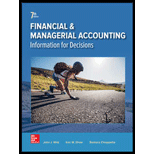
a.
The
Explanation: The net present value of alternative 1 is -$5,921.3.
Explanation:
Calculate the net present value as shown below.
| Particulars | Cash flow | Present value at 10% | Present value of net cash flow |
| Year 1 |
$8,000 |
0.9091 |
$7,272.8 |
| Year 2 |
$8,000 |
0.8264 |
$6,611.2 |
| Year 3 |
$8,000 |
0.7513 |
$6,010.4 |
| Year 4 |
$8,000 |
0.6830 |
$5,464.0 |
| Year 5 |
$8,000 |
0.6209 |
$4,967.2 |
| Year 6 |
$8,000 |
0.5645 |
$4,516.0 |
| Year 7 |
$8,000 |
0.5132 |
$4,105.6 |
| Year 8 |
$11,000 |
0.4665 |
$5,131.5 |
| Total |
$44,078.7 | ||
| Invested outflows |
$67,000 |
($50,000.0) | |
| Net present value |
-$5,921.3 | ||
Table – 1
Therefore, the net present value of alternative 1 is -$5,921.3.
Working Notes:
(a) On deduction of yearly operating cost from yearly revenues, the yearly cash flow is obtained.
(b) The
(c) The cost of old machine is not considered as the invested amount, as such cost is historical cost.
Conclusion:
Since the total cash flows are smaller than the invested amount, the net present value is negative.
b.
The net present value of alternative 2.
Explanation: The net present value of alternative 2 is $61,458.2.
Explanation:
Calculate the net present value as shown below.
| Particulars | Cash flow | Present value at 10% | Present value of net cash flow |
| Year 1 | $38,000 | 0.9091 | $34,545.8 |
| Year 2 | $38,000 | 0.8264 | $31,403.2 |
| Year 3 | $38,000 | 0.7513 | $28,549.4 |
| Year 4 | $38,000 | 0.6830 | $25,954.0 |
| Year 5 | $38,000 | 0.6209 | $23,594.2 |
| Year 6 | $38,000 | 0.5645 | $21,451.0 |
| Year 7 | $38,000 | 0.5132 | $19,501.6 |
| Year 8 | $46,000 | 0.4665 | $21,459.0 |
| Total cash flows | $206,458.2 | ||
| Invested outflows | $312,000 | ($145,000.0) | |
| Net present value | $61,458.2 | ||
Table – 2
Therefore, the net present value of alternative 2 is $61,458.2.
Working Notes:
(a) On deduction of yearly operating cost from yearly revenues, the yearly cash flow is obtained.
(b) The cash inflow of $46,000 is obtained by adding the salvage value of $8,000 is added in the actual cash inflow of the eighth year.
(c) The cost of old machine is not considered as the invested amount, as such cost is historical cost.
Conclusion:
Since the total cash flows are greater than the invested amount, the net present value is negative.
c.
To ascertain: The alternative to be recommended to management.
Explanation: Alternative 2 should be selected.
Explanation:
The projects or alternatives with positive NPV should be accepted, as the total cash flows are greater than the invested amount. The net present value of the alternative 1 is -$5,921.3 and that of alternative 2 is $61,458.2.
Hence, alternative 1 shows the negative net present value and alternative 2 shows positive net present value.
Conclusion:
Hence, alternative 2 should be recommended to the management.
a.
Explanation of Solution
The net present value of alternative 1 is -$5,921.3.
Since the total cash flows are smaller than the invested amount, the net present value is negative.
b.
The net present value of alternative 2.
b.
Explanation of Solution
The net present value of alternative 2 is $61,458.2.
Since the total cash flows are greater than the invested amount, the net present value is negative.
c.
To ascertain: The alternative to be recommended to management.
c.
Explanation of Solution
Alternative 2 should be selected.
Hence, alternative 2 should be recommended to the management.
Want to see more full solutions like this?
Chapter 24 Solutions
GEN COMBO LOOSELEAF FINANCIAL AND MANAGERIAL ACCOUNTING; CONNECT ACCESS CARD
- What is the correct answer with accounting questionarrow_forwardKimberly, Inc. has accounts receivable of $28,500, total assets of $342,000, cost of goods sold of $195,200, and a capital intensity ratio of 1.14. What is the accounts receivable turnover rate?arrow_forwardI am searching for the accurate solution to this general accounting problem with the right approach.arrow_forward
- OLX Enterprises purchased a machine for $325,000 on October 1, 2010. The estimated service life is ten years with a $32,600 residual value. OLX records partial-year depreciation based on the number of months in service. Depreciation expense for the year ended December 31, 2010, using straight-line depreciation, is?arrow_forwardFor Ikea Manufacturing, the predetermined overhead rate is 125% of direct labor cost. During the month, Ikea incurred $96,000 in total factory labor costs, of which $78,400 is direct labor and $17,600 is indirect labor. The actual manufacturing overhead incurred was $100,500. Compute the amount of manufacturing overhead applied during the month. Determine the amount of under- or overapplied manufacturing overhead.arrow_forwardWhat is the correct answer with general accountingarrow_forward
- Nonearrow_forwardRichard Gear Co. manufactures mountain bike tires. The tires sell for $75. The variable cost per tire is $40, and monthly fixed costs are $360,000. If the company is currently selling 18,000 tires monthly, what is the degree of operating leverage?arrow_forwardNo use ai . solve qnarrow_forward

 AccountingAccountingISBN:9781337272094Author:WARREN, Carl S., Reeve, James M., Duchac, Jonathan E.Publisher:Cengage Learning,
AccountingAccountingISBN:9781337272094Author:WARREN, Carl S., Reeve, James M., Duchac, Jonathan E.Publisher:Cengage Learning, Accounting Information SystemsAccountingISBN:9781337619202Author:Hall, James A.Publisher:Cengage Learning,
Accounting Information SystemsAccountingISBN:9781337619202Author:Hall, James A.Publisher:Cengage Learning, Horngren's Cost Accounting: A Managerial Emphasis...AccountingISBN:9780134475585Author:Srikant M. Datar, Madhav V. RajanPublisher:PEARSON
Horngren's Cost Accounting: A Managerial Emphasis...AccountingISBN:9780134475585Author:Srikant M. Datar, Madhav V. RajanPublisher:PEARSON Intermediate AccountingAccountingISBN:9781259722660Author:J. David Spiceland, Mark W. Nelson, Wayne M ThomasPublisher:McGraw-Hill Education
Intermediate AccountingAccountingISBN:9781259722660Author:J. David Spiceland, Mark W. Nelson, Wayne M ThomasPublisher:McGraw-Hill Education Financial and Managerial AccountingAccountingISBN:9781259726705Author:John J Wild, Ken W. Shaw, Barbara Chiappetta Fundamental Accounting PrinciplesPublisher:McGraw-Hill Education
Financial and Managerial AccountingAccountingISBN:9781259726705Author:John J Wild, Ken W. Shaw, Barbara Chiappetta Fundamental Accounting PrinciplesPublisher:McGraw-Hill Education





